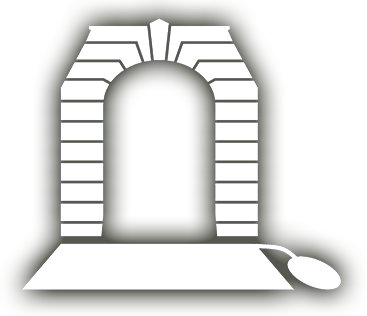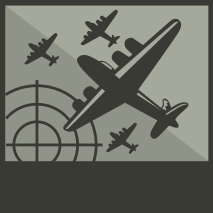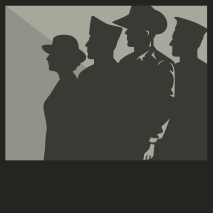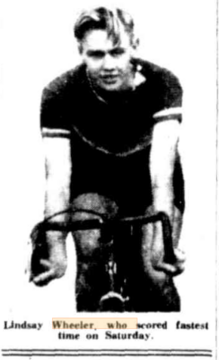
WHEELER, Lindsay William
| Service Number: | 409807 |
|---|---|
| Enlisted: | 10 October 1941 |
| Last Rank: | Warrant Officer |
| Last Unit: | No. 106 Squadron (RAF) |
| Born: | Melbourne, Victoria, Australia, 30 December 1916 |
| Home Town: | Moonee Ponds, Moonee Valley, Victoria |
| Schooling: | St Colemans College, Fitzroy, Victoria, Australia |
| Occupation: | Clerk |
| Died: | Flying Battle, Germany, 19 September 1944, aged 27 years |
| Cemetery: |
Reichswald Forest War Cemetery, Germany Plot 7, Row G, Grave 2 Headstone inscription reads;Our brave and noble 'Lin' ever remembered and loved by all, Reichswald Forest War Cemetery, Kleve, Germany |
| Memorials: | Australian War Memorial Roll of Honour, International Bomber Command Centre Memorial |
World War 2 Service
| 3 Sep 1939: | Involvement Warrant Officer, 409807 | |
|---|---|---|
| 10 Oct 1941: | Involvement Royal Australian Air Force, No. 1 Initial Training School Somers | |
| 10 Oct 1941: | Enlisted Royal Australian Air Force, Warrant Officer, 409807, No. 106 Squadron (RAF), Enlisted at Melbourne, Victoria | |
| 10 Oct 1941: | Enlisted Royal Australian Air Force, Warrant Officer, 409807 | |
| 11 Dec 1941: | Involvement Royal Australian Air Force, Air Gunnery Schools, Attended 2 WAGS at Parkes followed by 2 BAGS at Port Pirie | |
| 8 Aug 1942: | Embarked Royal Australian Air Force, 1 Embarkation Depot, Departed Sydney by troop transport for UK via North America, arriving at 3 PDRC Bournemouth on 18 November 1942 | |
| 23 Dec 1942: | Involvement Royal Air Force , 1 Advanced Flying Unit (RAF), Air War NW Europe 1939-45 | |
| 24 Feb 1943: | Involvement Royal Air Force , Air and Ground Radio School | |
| 10 May 1943: | Involvement Royal Air Force , Operational Training Units (RAF), No. 7 Coastal Command OTU at RAF Turnberry and 1 Torpedo Training Unit ar RAF Lindavady | |
| 1 Feb 1944: | Involvement Royal Air Force , 2 Observer Advanced Flying Unit (Millom) | |
| 21 Mar 1944: | Involvement Royal Air Force , Operational Training Units (RAF), 29 OTU at RAF Bitteswell | |
| 28 Jun 1944: | Involvement Royal Australian Air Force, 51 Base Headquarters, Qualifying for operational flying in Lancasters via 1654 HCU and 5 LFS | |
| 11 Sep 1944: | Involvement Royal Air Force , No. 106 Squadron (RAF), Air War NW Europe 1939-45, KIA on 20th September during raid on Rheydt |
Help us honour Lindsay William Wheeler's service by contributing information, stories, and images so that they can be preserved for future generations.
Add my storyBiography contributed by Carol Foster
Son of John Francis and Elsie Wheeler; husband of Mary Victories Wheeler of West Footscray, Victoria
Plane was Lancaster PB 347 which was lost during air operations over Germany
Biography contributed by STEVEN WESTWOOD
Disclaimer
The account which follows is based on information from online resources concerning the life and war service of Lindsay William Wheeler. The primary sources were his RAAF service record and the separate casualty report, from the digitised versions available through the National Archives of Australia website.
The author’s intention in posting this biography is, in a small way, to pay honour to the memory of his achievements and sacrifice. I have no connection to his family or acquaintances and request their forgiveness, and would welcome corrections, if anything that appears here is inappropriate or factually incorrect.
Introduction
Lindsay Wheeler, known throughout his life as Lin, was born on 30th December 1916 into the large family of John and Elsie Wheeler and raised within the Roman Catholic community in the inner-western suburbs of Melbourne. At the time of his enlistment, his father was employed as a police auxillary.
At twelve years of age in 1928 Lin completed the Victorian Department of Education Merit Certificate and subsequently attended various local Roman Catholic colleges for another two and a half years, apparently without completing the Intermediate Certificate. From school he was employed initially as a shop assistant and later an assistant book keeper until becoming a clerk with the AMP Insurance Company at their Moonee Ponds branch.
His avocation however was road race cycling. In 1936 when still only 19 he won the Victorian 100 Mile Road Racing Championships and two years later, with his older brother Chris, was a member of the Footscray team which won the Victorian Cycling premier competiton. Chris represented Australia in the 100 km road race at the 1936 Berlin Olympics and Lin set his sights on emulating him by competing at the next Olympics, at that time scheduled to be held in Tokyo in 1940. These dreams were put on hold when Japan withdrew from hosting the Games in 1938 and his primary ambition in amateur cycling ended for good when it became clear there was no likelihood of an Olympics being staged in the immediate future. He instead chose to relinquish his amateur status and follow his brother into a career in professional cycling.
However in September 1940 his sporting ambitions were put to one side when he submitted an application to join the RAAF. His motivation for taking this step is not recorded but he was a part of the surge in recruitment into the armed forces in Australia that coincided with and no doubt resulted from the perilous situation Britain found itself in following the fall of France. In his application he lists his occupation as clerk and his principal sporting activity as professional cyclist.
Despite having no relevant aviation experience and only a minimum level of educational qualification his application was accepted and he was enrolled into the RAAF Reserve in October 1940, serial number 409807. The report accompanying his medical examination noted he had scars on both shoulders and on the upper third of both thighs, no doubt most if not all the result of various crashes that had occurred in the course of his cycling career.
RAAF Training in Australia
As was commonly the case, due to an oversupply of enrolments and limited local training facilities, there was a significant delay before he was officially called up. Thus it was not until the 10th October 1941, now as part of Australia’s contribution to the Empire Air Training Scheme, that he formally enlisted in the RAAF at their No. 1 Recruiting Centre in Queens St, Melbourne, where he undertook to serve for: “the duration of the war and twelve months thereafter” with his RAAF service commencing at the No. 1 Initial Training School (1 ITS) located at Somers just outside Melbourne. Another major event took place shortly thereafter, while his initial training was underway, when he married Mary Victoire Vaughan in Yarraville in November that year.
His basic training concluded in the same week as the attack on Pearl Harbour. As Japanese forces rampaged southwards, culminating in the shock of the fall of Singapore in February 1942, he was posted first to a course at No. 2 Wireless Air Gunners School (2 WAGS) at Parkes, NSW and subsequently to No. 2 Bombing & Gunnery School (2 BAGS) at Port Pirie, SA. On completion he had qualified to wear the brevet of a wireless operator/air gunner. After a month of pre-embarkation leave he departed by ship from Sydney heading for active service in the UK on 24th July 1942.
RAF Training and Initial Service in England
The route by which he travelled to the UK is not noted but at this stage of the war, with the Imperial Japanese Navy dominant throughout the Central Pacific and Indian Oceans, his troop transport would have proceeded east from Sydney, most likely via a stop in New Zealand, across the Pacific to land on the west coast of the USA, usually at San Francisco. Crossing North America by train, then reboarding a second transport in Halifax on Canada’s east coast for the voyage across the U-boat patrolled waters of the North Atlantic to the UK. He arrived at his initial destination, the RAAF’s Personnel Reception Centre at the seaside town of Bournemouth on the 18th November 1942, nearly four months after leaving Sydney. It would still be nearly another two years before he would finally, briefly, reach active service with Bomber Command.
Lin’s first assignments were “refresher” courses - in wireless communications, at 11 Radio School at Hooton Park, and in Morse transmission at 10 Recruit Centre at Blackpool. Apparently destined for a role within Coastal Command, he proceeded next to No. 7 Coastal Operational Training Unit at RAF Limavady in Northern Ireland and then 1 Torpedo Training Unit at RAF Turnberry in Scotland. He was trained for service in an aerial torpedo bomber however the final stages of this training coincided with a revision of RAF priorities which resulted in a decision to reduce its ongoing requirements for torpedo bombers.
As a result by the end of his training he was surplus to the revised needs of Coastal Command and was reassigned to duties with Ferry Command instead. He passed the remainder of 1943 there, probably delivering aircraft to airbases within the UK and in North Africa and the Middle East. On 26th December 1943 he was based at an undisclosed location in North Africa, from where he embarked - by ship rather than plane - and returned to the UK on 4th January 1944.
A few weeks later he was transferred to Bomber Command. Its need for qualified aircrew was urgent, to replace the brutal losses it had suffered during the so-called Battle of Berlin - the night bombing campaign focussed on the German capital over the 1943/44 winter. He entered into the well-established training pipeline leading to qualification for operational flying with a heavy bomber unit, a process which in his case took seven months. Starting at an Advanced Flying Unit, he crewed up while at 29 OTU flying Wellingtons and converted to flying four-engined heavy bombers at 1654 HCU (RAF Wigsley) before completing training with 5 Lancaster Finishing School (RAF Syerston).
With 106 Squadron
On the 11th September 1944, over four years since he had submitted his initial application to join the RAAF, the newly promoted Warrant Officer Lindsay Wheeler arrived at RAF Metheringham eager to commence active flying duties with 106 Sqn of 5 Group. His six crewmates were English. His crew’s pilot, F/O Anthony Brindley, was a 21 y/o from Barnstaple in Devon who had enlisted into the RAF after completing his undergraduate degree at Downing College, Cambridge in 1942.
At 27 years of age Lin was, by four years, the “old man” of his crew. The two machine gunners, Sgts Peter Feltham and Rex Chatwin, were both only 19 years old.
106 Squadron had had a distinguished record of achievement and sacrifice in the “front line” of Bomber Command over the previous four years, but the arrival of Lin with his crewmates coincided with a significant change in its assigned role. In future its primary purpose was to act as the starting point to train new crews earmarked to ultimately join 5 Group’s two elite Lancaster-equipped Pathfinder Squadrons – 83 Sqn and 97 Sqn. As stated at the conclusion of the entry in the Squadron Operational Record Book for 13th September 1944:
“This new policy will mean that although the Squadron will operate at a considerably reduced effort it will assume the important responsibility of being a Pathfinder nursery”
Being assigned to 106 Sqn thus indicates Lin Wheeler was the member of a crew that had performed well during the training process, sufficient to warrant selection as a candidate to join the elite ranks of the Pathfinders.
In their first week at Metheringham their flying would have been limited to training flights for familiarization with the surrounding area and especially the approaches to the airfield, with a focus on the specific challenge of safely taking off with a fully-loaded Lancaster and landing back at night.
Rheydt
During the night of 19th/20th September 1944 the adjacent targets of Mönchengladbach and Rheydt, in Westphalia on the western edge of the Ruhr Valley, were attacked by 272 Lancaster bombers from 1 and 5 Group supported by 10 Pathfinder Mosquitoes. The raid, which was the second on this target within a fortnight, was assessed by Bomber Commandto have been a success. It was reported to have resulted in significant damage to local industrial and factory areas as well as “dehousing” a significant portion of the population of both cities.
Tuesday 19th September 1944 was an overcast day in Lincolnshire with intermittent light showers. We can only speculate how Lin felt when notified that his was one of the aircraft from the squadron on call for a raid that night. He would be flying in a Mark III Lancaster, serial number PB347, with squadron marking LN-G. His Squadron Commander wrote in a letter to Lin’s wife after he was reported missing that:
“I had been much impressed by his keenness and enthusiasm, and his very real desire “to go into action” “
The literal veracity of these words should probably be taken with a grain of salt. Lin had barely been with the squadron for a week, so it’s a moot point how many opportunities he would have had for private conversation with the base commander in that time. It is however hard to imagine that a combination of excitement, relief and apprehension at the prospect of finally going into action over Germany after all this time were not prominent among his emotions that day.
The Allied front lines in Western Europe by this date had moved up to and across the Dutch border to the north and were approaching the German border to the east. This allowed the main bomber force to be routed, for the first time since the fall of France in 1940, out of range of German flak defenses for the majority of its progress over Belgium. As a result losses to the main force this night were light. Four Lancasters were shot down by enemy action with a fifth damaged beyond repair while landing back at base. 21 of the aircrew on these planes were killed while another 8 survived as prisoners of war.
This raid is currently primarily remembered for the additional loss of the Master Bomber assigned to coordinate the attack on Rheydt, W/Cdr Gibson VC DSO & Bar, DFC & Bar. He died along with his navigator S/Ldr Jim Warwick when their Mosquito, KB267 of 627 Sqn, crashed at Steenbergen on the Dutch North Sea coast on its return flight. Coincidentally Gibson was a former commander of 106 Sqn having left in February 1943 to take on the organization of what was to become 617 Sqn and to command the legendary Dambusters Raid in May 1943.
Eighteen aircraft from 106 Sqn took part in the raid, taking off from RAF Metheringham in the early evening. PB347 was one of the last to get airborne at 7.10 pm. It crossed into Europe south of Ostend and followed a south west heading across Belgium. From 9 pm the main force bombers began to arrive at a point south of Brussels where they turned onto a north easterly heading for the run into enemy territory as they approached their target.
The sequence of events that resulted in the loss of PB347 will never be known but it appears most likely it was intercepted by a night fighter after releasing its bombs, jus as it was starting out on the return leg. At 11.15 pm the aircraft was seen from the ground to explode in mid-air and it crashed in flames shortly thereafter 40 km south west of Dusseldorf near the village of Elempt. Wreckage from the plane and the remains of the crew were spread throughout a local forest.
Aftermath
The bomb aimer, F/O Ken Ayres, was the sole member of the crew of PB347 to survive the initial crash. The only information available about his subsequent fate comes from a posting in an online forum which claimed that after evading initial capture Ayres was picked up four days later in Southern Holland and sent as a POW to Stalag Luft 1. There is no further record of the final moments of the plane, how he escaped from the plane or his time as a prisoner of war. He is lost to history as one of the “missing” who disappeared in the chaos of eastern Germany when the war drew to a close in 1945.
The 106 Squadron Operational Record Book entry for PB347 for this night reads:
“Nothing further heard from this aircraft after takeoff. MISSING”
By the evening of 23rd September local time in Melbourne his wife and his parents had separately been notified by telegram that Lin was missing. A year later information found in German records indicated Lin had been buried along with the remains of five other of his crew members in a cemetery in North Dusseldorf on the 22nd September 1944.
An on-site investigation of the circumstances of the crash was carried out in January 1947 by the RAF’s Missing Research and Enquiry Unit and included an exhumation of the crew’s assigned graves in the North Dusseldorf Cemetery. One grave contained an initially unidentified body found to be wearing remnants of an RAAF uniform and with a portion of Lin’s service number visible on the neckband of a shirt. It was thus identified beyond reasonable doubt to be that of Lindsay Wheeler, the only Australian in the crew of PB347 that night.
A summary of the MREU report was provided by the RAAF authorities to Wheeler’s parents in October 1948 but only in response to an enquiry from his mother asking if any further information about her son’s death had come to light.
W/O Lin Wheeler along with five of his crew mates who perished with him on their first and only operational flight were reburied in the Reichswald Forest War Cemetery in 1956. The epitaph on his CWGC gravestone reads:
Our brave and noble “Lin”
Ever remembered
And loved by all
In July 1946 the Footscray Cycling Club held a 40-mile road race as a memorial to Lin with prizes and trophies donated by his family. The race was started by Chris Wheeler, himself by then a veteran of war service with the 2nd AIF.
In a bizarre footnote to this story, in January 1965 RAAF staff in London were contacted by UK police for assistance in identifying the owner of a kitbag found at the scene of a local crime. The bag was of RAAF wartime issue and bore Lin Wheeler’s service number, 409807. No explanation of why or how it ended up at a crime scene was established.
Submitted by Steven Westwood (September 2025)
Biography contributed by STEVEN WESTWOOD
Disclaimer
The account which follows is based on information from online resources concerning the life and war service of Lindsay William Wheeler. The primary sources were his RAAF service record and the separate casualty report, from the digitised versions available through the National Archives of Australia website.
The author’s intention in posting this biography is, in a small way, to pay honour to the memory of his achievements and sacrifice. I have no connection to his family or acquaintances and request their forgiveness, and would welcome corrections, if anything that appears here is inappropriate or factually incorrect.
Introduction
Lindsay Wheeler, known throughout his life as Lin, was born on 30th December 1916 into the large family of John and Elsie Wheeler and raised within the Roman Catholic community in the inner-western suburbs of Melbourne. At the time of his enlistment, his father was employed as a police auxillary.
At twelve years of age in 1928 Lin completed the Victorian Department of Education Merit Certificate and subsequently attended various local Roman Catholic colleges for another two and a half years, apparently without completing the Intermediate Certificate. From school he was employed initially as a shop assistant and later an assistant book keeper until becoming a clerk with the AMP Insurance Company at their Moonee Ponds branch.
His avocation however was road race cycling. In 1936 when still only 19 he won the Victorian 100 Mile Road Racing Championships and two years later, with his older brother Chris, was a member of the Footscray team which won the Victorian Cycling premier competiton. Chris represented Australia in the 100 km road race at the 1936 Berlin Olympics and Lin set his sights on emulating him by competing at the next Olympics, at that time scheduled to be held in Tokyo in 1940. These dreams were put on hold when Japan withdrew from hosting the Games in 1938 and his primary ambition in amateur cycling ended for good when it became clear there was no likelihood of an Olympics being staged in the immediate future. He instead chose to relinquish his amateur status and follow his brother into a career in professional cycling.
However in September 1940 his sporting ambitions were put to one side when he submitted an application to join the RAAF. His motivation for taking this step is not recorded but he was a part of the surge in recruitment into the armed forces in Australia that coincided with and no doubt resulted from the perilous situation Britain found itself in following the fall of France. In his application he lists his occupation as clerk and his principal sporting activity as professional cyclist.
Despite having no relevant aviation experience and only a minimum level of educational qualification his application was accepted and he was enrolled into the RAAF Reserve in October 1940, serial number 409807. The report accompanying his medical examination noted he had scars on both shoulders and on the upper third of both thighs, no doubt most if not all the result of various crashes that had occurred in the course of his cycling career.
RAAF Training in Australia
As was commonly the case, due to an oversupply of enrolments and limited local training facilities, there was a significant delay before he was officially called up. Thus it was not until the 10th October 1941, now as part of Australia’s contribution to the Empire Air Training Scheme, that he formally enlisted in the RAAF at their No. 1 Recruiting Centre in Queens St, Melbourne, where he undertook to serve for: “the duration of the war and twelve months thereafter” with his RAAF service commencing at the No. 1 Initial Training School (1 ITS) located at Somers just outside Melbourne. Another major event took place shortly thereafter, while his initial training was underway, when he married Mary Victoire Vaughan in Yarraville in November that year.
His basic training concluded in the same week as the attack on Pearl Harbour. As Japanese forces rampaged southwards, culminating in the shock of the fall of Singapore in February 1942, he was posted first to a course at No. 2 Wireless Air Gunners School (2 WAGS) at Parkes, NSW and subsequently to No. 2 Bombing & Gunnery School (2 BAGS) at Port Pirie, SA. On completion he had qualified to wear the brevet of a wireless operator/air gunner. After a month of pre-embarkation leave he departed by ship from Sydney heading for active service in the UK on 24th July 1942.
RAF Training and Initial Service in England
The route by which he travelled to the UK is not noted but at this stage of the war, with the Imperial Japanese Navy dominant throughout the Central Pacific and Indian Oceans, his troop transport would have proceeded east from Sydney, most likely via a stop in New Zealand, across the Pacific to land on the west coast of the USA, usually at San Francisco. Crossing North America by train, then reboarding a second transport in Halifax on Canada’s east coast for the voyage across the U-boat patrolled waters of the North Atlantic to the UK. He arrived at his initial destination, the RAAF’s Personnel Reception Centre at the seaside town of Bournemouth on the 18th November 1942, nearly four months after leaving Sydney. It would still be nearly another two years before he would finally, briefly, reach active service with Bomber Command.
Lin’s first assignments were “refresher” courses - in wireless communications, at 11 Radio School at Hooton Park, and in Morse transmission at 10 Recruit Centre at Blackpool. Apparently destined for a role within Coastal Command, he proceeded next to No. 7 Coastal Operational Training Unit at RAF Limavady in Northern Ireland and then 1 Torpedo Training Unit at RAF Turnberry in Scotland. He was trained for service in an aerial torpedo bomber however the final stages of this training coincided with a revision of RAF priorities which resulted in a decision to reduce its ongoing requirements for torpedo bombers.
As a result by the end of his training he was surplus to the revised needs of Coastal Command and was reassigned to duties with Ferry Command instead. He passed the remainder of 1943 there, probably delivering aircraft to airbases within the UK and in North Africa and the Middle East. On 26th December 1943 he was based at an undisclosed location in North Africa, from where he embarked - by ship rather than plane - and returned to the UK on 4th January 1944.
A few weeks later he was transferred to Bomber Command. Its need for qualified aircrew was urgent, to replace the brutal losses it had suffered during the so-called Battle of Berlin - the night bombing campaign focussed on the German capital over the 1943/44 winter. He entered into the well-established training pipeline leading to qualification for operational flying with a heavy bomber unit, a process which in his case took seven months. Starting at an Advanced Flying Unit, he crewed up while at 29 OTU flying Wellingtons and converted to flying four-engined heavy bombers at 1654 HCU (RAF Wigsley) before completing training with 5 Lancaster Finishing School (RAF Syerston).
With 106 Squadron
On the 11th September 1944, over four years since he had submitted his initial application to join the RAAF, the newly promoted Warrant Officer Lindsay Wheeler arrived at RAF Metheringham eager to commence active flying duties with 106 Sqn of 5 Group. His six crewmates were English. His crew’s pilot, F/O Anthony Brindley, was a 21 y/o from Barnstaple in Devon who had enlisted into the RAF after completing his undergraduate degree at Downing College, Cambridge in 1942.
At 27 years of age Lin was, by four years, the “old man” of his crew. The two machine gunners, Sgts Peter Feltham and Rex Chatwin, were both only 19 years old.
106 Squadron had had a distinguished record of achievement and sacrifice in the “front line” of Bomber Command over the previous four years, but the arrival of Lin with his crewmates coincided with a significant change in its assigned role. In future its primary purpose was to act as the starting point to train new crews earmarked to ultimately join 5 Group’s two elite Lancaster-equipped Pathfinder Squadrons – 83 Sqn and 97 Sqn. As stated at the conclusion of the entry in the Squadron Operational Record Book for 13th September 1944:
“This new policy will mean that although the Squadron will operate at a considerably reduced effort it will assume the important responsibility of being a Pathfinder nursery”
Being assigned to 106 Sqn thus indicates Lin Wheeler was the member of a crew that had performed well during the training process, sufficient to warrant selection as a candidate to join the elite ranks of the Pathfinders.
In their first week at Metheringham their flying would have been limited to training flights for familiarization with the surrounding area and especially the approaches to the airfield, with a focus on the specific challenge of safely taking off with a fully-loaded Lancaster and landing back at night.
Rheydt
During the night of 19th/20th September 1944 the adjacent targets of Mönchengladbach and Rheydt, in Westphalia on the western edge of the Ruhr Valley, were attacked by 272 Lancaster bombers from 1 and 5 Group supported by 10 Pathfinder Mosquitoes. The raid, which was the second on this target within a fortnight, was assessed by Bomber Commandto have been a success. It was reported to have resulted in significant damage to local industrial and factory areas as well as “dehousing” a significant portion of the population of both cities.
Tuesday 19th September 1944 was an overcast day in Lincolnshire with intermittent light showers. We can only speculate how Lin felt when notified that his was one of the aircraft from the squadron on call for a raid that night. He would be flying in a Mark III Lancaster, serial number PB347, with squadron marking LN-G. His Squadron Commander wrote in a letter to Lin’s wife after he was reported missing that:
“I had been much impressed by his keenness and enthusiasm, and his very real desire “to go into action” “
The literal veracity of these words should probably be taken with a grain of salt. Lin had barely been with the squadron for a week, so it’s a moot point how many opportunities he would have had for private conversation with the base commander in that time. It is however hard to imagine that a combination of excitement, relief and apprehension at the prospect of finally going into action over Germany after all this time were not prominent among his emotions that day.
The Allied front lines in Western Europe by this date had moved up to and across the Dutch border to the north and were approaching the German border to the east. This allowed the main bomber force to be routed, for the first time since the fall of France in 1940, out of range of German flak defenses for the majority of its progress over Belgium. As a result losses to the main force this night were light. Four Lancasters were shot down by enemy action with a fifth damaged beyond repair while landing back at base. 21 of the aircrew on these planes were killed while another 8 survived as prisoners of war.
This raid is currently primarily remembered for the additional loss of the Master Bomber assigned to coordinate the attack on Rheydt, W/Cdr Gibson VC DSO & Bar, DFC & Bar. He died along with his navigator S/Ldr Jim Warwick when their Mosquito, KB267 of 627 Sqn, crashed at Steenbergen on the Dutch North Sea coast on its return flight. Coincidentally Gibson was a former commander of 106 Sqn having left in February 1943 to take on the organization of what was to become 617 Sqn and to command the legendary Dambusters Raid in May 1943.
Eighteen aircraft from 106 Sqn took part in the raid, taking off from RAF Metheringham in the early evening. PB347 was one of the last to get airborne at 7.10 pm. It crossed into Europe south of Ostend and followed a south west heading across Belgium. From 9 pm the main force bombers began to arrive at a point south of Brussels where they turned onto a north easterly heading for the run into enemy territory as they approached their target.
The sequence of events that resulted in the loss of PB347 will never be known but it appears most likely it was intercepted by a night fighter after releasing its bombs, jus as it was starting out on the return leg. At 11.15 pm the aircraft was seen from the ground to explode in mid-air and it crashed in flames shortly thereafter 40 km south west of Dusseldorf near the village of Elempt. Wreckage from the plane and the remains of the crew were spread throughout a local forest.
Aftermath
The bomb aimer, F/O Ken Ayres, was the sole member of the crew of PB347 to survive the initial crash. The only information available about his subsequent fate comes from a posting in an online forum which claimed that after evading initial capture Ayres was picked up four days later in Southern Holland and sent as a POW to Stalag Luft 1. There is no further record of the final moments of the plane, how he escaped from the plane or his time as a prisoner of war. He is lost to history as one of the “missing” who disappeared in the chaos of eastern Germany when the war drew to a close in 1945.
The 106 Squadron Operational Record Book entry for PB347 for this night reads:
“Nothing further heard from this aircraft after takeoff. MISSING”
By the evening of 23rd September local time in Melbourne his wife and his parents had separately been notified by telegram that Lin was missing. A year later information found in German records indicated Lin had been buried along with the remains of five other of his crew members in a cemetery in North Dusseldorf on the 22nd September 1944.
An on-site investigation of the circumstances of the crash was carried out in January 1947 by the RAF’s Missing Research and Enquiry Unit and included an exhumation of the crew’s assigned graves in the North Dusseldorf Cemetery. One grave contained an initially unidentified body found to be wearing remnants of an RAAF uniform and with a portion of Lin’s service number visible on the neckband of a shirt. It was thus identified beyond reasonable doubt to be that of Lindsay Wheeler, the only Australian in the crew of PB347 that night.
A summary of the MREU report was provided by the RAAF authorities to Wheeler’s parents in October 1948 but only in response to an enquiry from his mother asking if any further information about her son’s death had come to light.
W/O Lin Wheeler along with five of his crew mates who perished with him on their first and only operational flight were reburied in the Reichswald Forest War Cemetery in 1956. The epitaph on his CWGC gravestone reads:
Our brave and noble “Lin”
Ever remembered
And loved by all
In July 1946 the Footscray Cycling Club held a 40-mile road race as a memorial to Lin with prizes and trophies donated by his family. The race was started by Chris Wheeler, himself by then a veteran of war service with the 2nd AIF.
In a bizarre footnote to this story, in January 1965 RAAF staff in London were contacted by UK police for assistance in identifying the owner of a kitbag found at the scene of a local crime. The bag was of RAAF wartime issue and bore Lin Wheeler’s service number, 409807. No explanation of why or how it ended up at a crime scene was established.
Submitted by Steven Westwood (September 2025)










